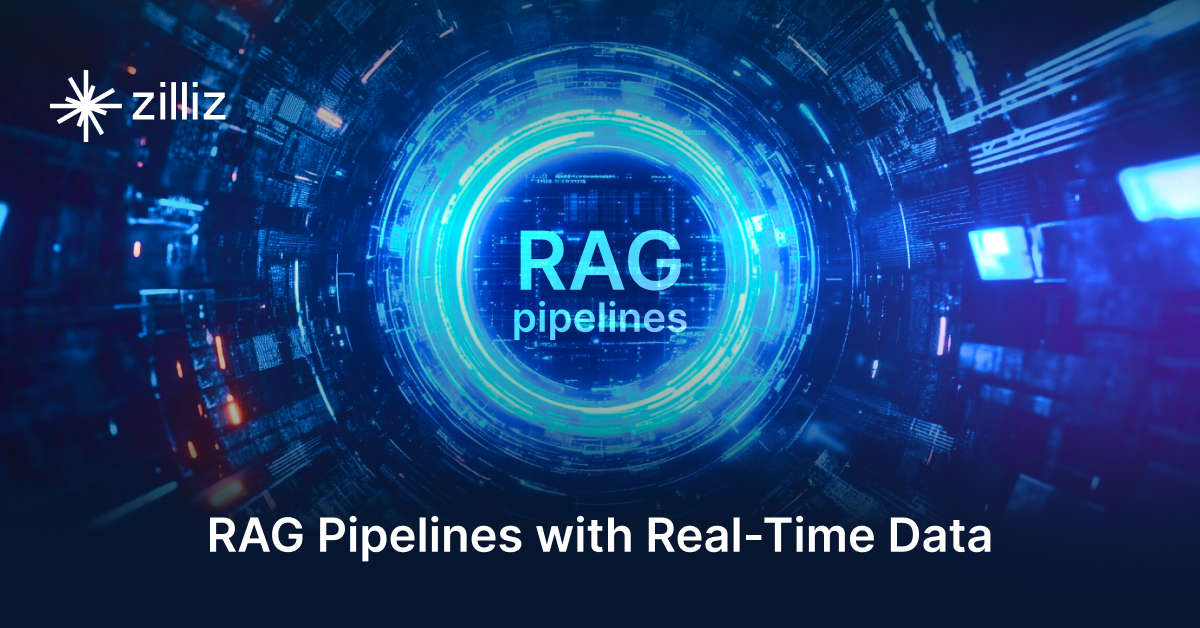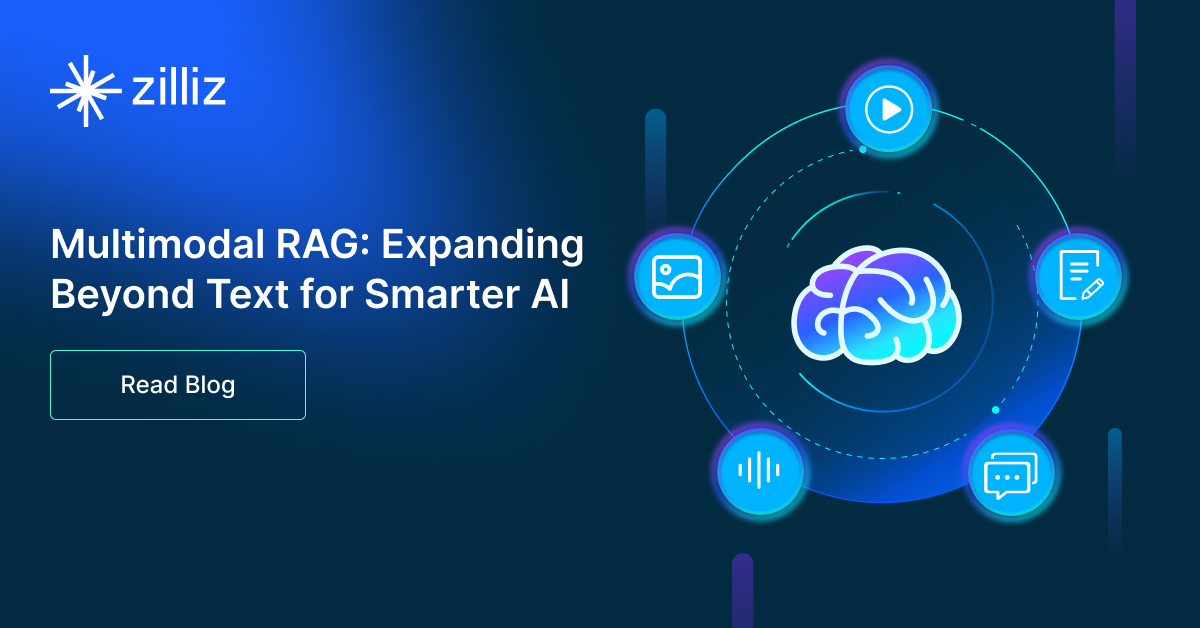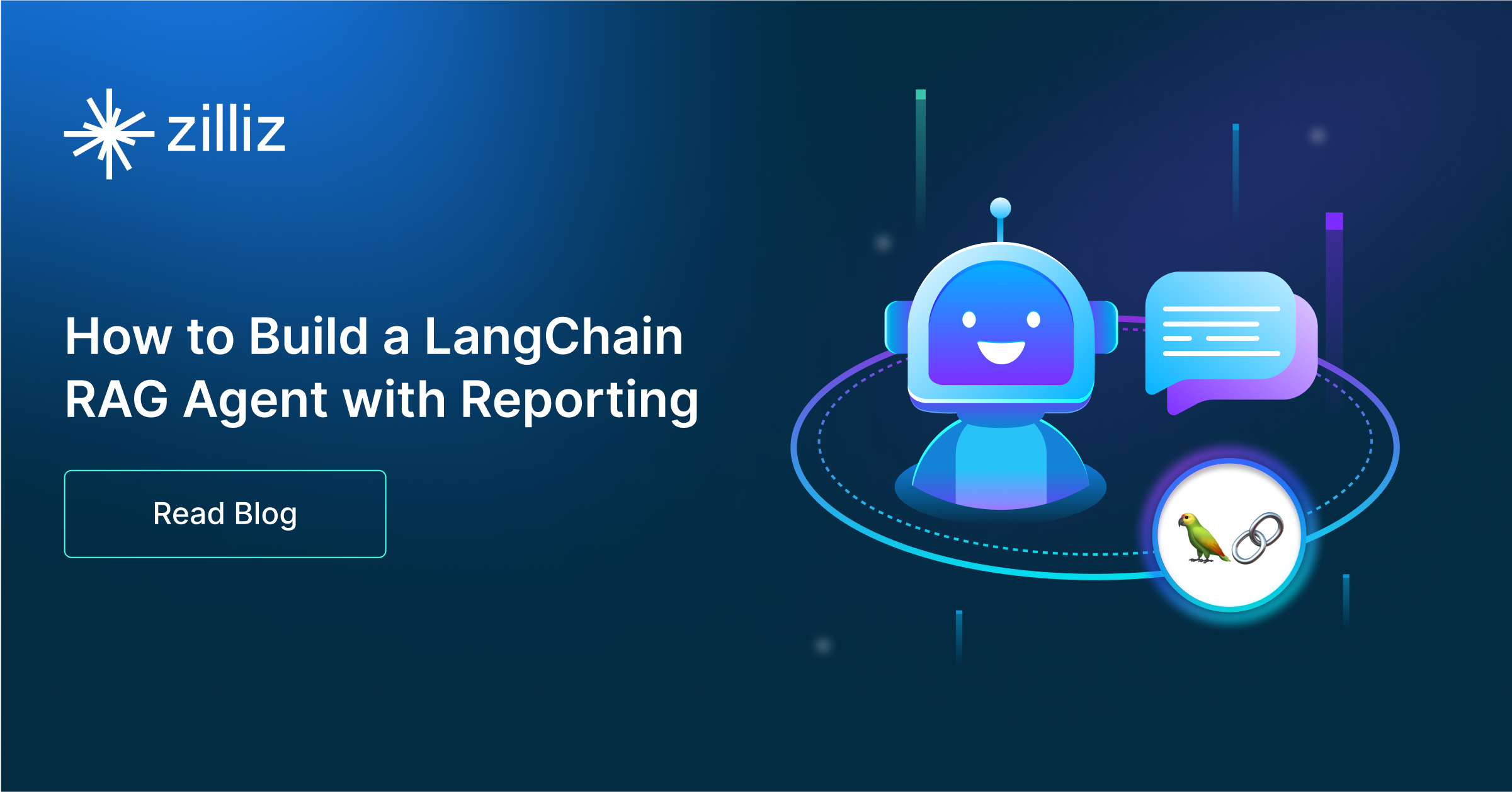Build RAG Chatbot with LangChain, OpenSearch, Mistral AI Mistral Large, and NVIDIA embed-qa-4
Introduction to RAG
Retrieval-Augmented Generation (RAG) is a game-changer for GenAI applications, especially in conversational AI. It combines the power of pre-trained large language models (LLMs) like OpenAI’s GPT with external knowledge sources stored in vector databases such as Milvus and Zilliz Cloud, allowing for more accurate, contextually relevant, and up-to-date response generation. A RAG pipeline usually consists of four basic components: a vector database, an embedding model, an LLM, and a framework.
Key Components We'll Use for This RAG Chatbot
This tutorial shows you how to build a simple RAG chatbot in Python using the following components:
- LangChain: An open-source framework that helps you orchestrate the interaction between LLMs, vector stores, embedding models, etc, making it easier to integrate a RAG pipeline.
- OpenSearch: An open-source search and analytics suite derived from Elasticsearch. It offers robust full-text search and real-time analytics, with vector search available as an add-on for similarity-based queries, extending its capabilities to handle high-dimensional data. Since it is just a vector search add-on rather than a purpose-built vector database, it lacks scalability and availability and many other advanced features required by enterprise-level applications. Therefore, if you prefer a much more scalable solution or hate to manage your own infrastructure, we recommend using Zilliz Cloud, which is a fully managed vector database service built on the open-source Milvus and offers a free tier supporting up to 1 million vectors.)
- Mistral AI Mistral Large: This model offers a high-performance solution for a range of natural language processing tasks. With a focus on large-scale text generation and comprehension, it excels in handling complex queries and generating nuanced responses. Ideal for applications in content creation, conversational agents, and research analysis, Mistral Large combines versatility with efficiency.
- NVIDIA embed-qa-4: This model specializes in question answering tasks, leveraging cutting-edge embedding techniques to enhance accuracy and comprehension. Its strengths lie in understanding context and retrieving precise information effectively. Ideal for applications in customer support, educational platforms, and any domain needing rapid, context-aware responses to user inquiries.
By the end of this tutorial, you’ll have a functional chatbot capable of answering questions based on a custom knowledge base.
Note: Since we may use proprietary models in our tutorials, make sure you have the required API key beforehand.
Step 1: Install and Set Up LangChain
%pip install --quiet --upgrade langchain-text-splitters langchain-community langgraph
Step 2: Install and Set Up Mistral AI Mistral Large
pip install -qU "langchain[mistralai]"
import getpass
import os
if not os.environ.get("MISTRAL_API_KEY"):
os.environ["MISTRAL_API_KEY"] = getpass.getpass("Enter API key for Mistral AI: ")
from langchain.chat_models import init_chat_model
llm = init_chat_model("mistral-large-latest", model_provider="mistralai")
Step 3: Install and Set Up NVIDIA embed-qa-4
pip install -qU langchain-nvidia-ai-endpoints
import getpass
import os
if not os.environ.get("NVIDIA_API_KEY"):
os.environ["NVIDIA_API_KEY"] = getpass.getpass("Enter API key for NVIDIA: ")
from langchain_nvidia_ai_endpoints import NVIDIAEmbeddings
embeddings = NVIDIAEmbeddings(model="NV-Embed-QA")
Step 4: Install and Set Up OpenSearch
pip install --upgrade --quiet opensearch-py langchain-community
from langchain_community.vectorstores import OpenSearchVectorSearch
opensearch_vector_search = OpenSearchVectorSearch(
"http://localhost:9200",
"embeddings",
embedding_function
)
Step 5: Build a RAG Chatbot
Now that you’ve set up all components, let’s start to build a simple chatbot. We’ll use the Milvus introduction doc as a private knowledge base. You can replace it with your own dataset to customize your RAG chatbot.
import bs4
from langchain import hub
from langchain_community.document_loaders import WebBaseLoader
from langchain_core.documents import Document
from langchain_text_splitters import RecursiveCharacterTextSplitter
from langgraph.graph import START, StateGraph
from typing_extensions import List, TypedDict
# Load and chunk contents of the blog
loader = WebBaseLoader(
web_paths=("https://milvus.io/docs/overview.md",),
bs_kwargs=dict(
parse_only=bs4.SoupStrainer(
class_=("doc-style doc-post-content")
)
),
)
docs = loader.load()
text_splitter = RecursiveCharacterTextSplitter(chunk_size=1000, chunk_overlap=200)
all_splits = text_splitter.split_documents(docs)
# Index chunks
_ = vector_store.add_documents(documents=all_splits)
# Define prompt for question-answering
prompt = hub.pull("rlm/rag-prompt")
# Define state for application
class State(TypedDict):
question: str
context: List[Document]
answer: str
# Define application steps
def retrieve(state: State):
retrieved_docs = vector_store.similarity_search(state["question"])
return {"context": retrieved_docs}
def generate(state: State):
docs_content = "\n\n".join(doc.page_content for doc in state["context"])
messages = prompt.invoke({"question": state["question"], "context": docs_content})
response = llm.invoke(messages)
return {"answer": response.content}
# Compile application and test
graph_builder = StateGraph(State).add_sequence([retrieve, generate])
graph_builder.add_edge(START, "retrieve")
graph = graph_builder.compile()
Test the Chatbot
Yeah! You've built your own chatbot. Let's ask the chatbot a question.
response = graph.invoke({"question": "What data types does Milvus support?"})
print(response["answer"])
Example Output
Milvus supports various data types including sparse vectors, binary vectors, JSON, and arrays. Additionally, it handles common numerical and character types, making it versatile for different data modeling needs. This allows users to manage unstructured or multi-modal data efficiently.
Optimization Tips
As you build your RAG system, optimization is key to ensuring peak performance and efficiency. While setting up the components is an essential first step, fine-tuning each one will help you create a solution that works even better and scales seamlessly. In this section, we’ll share some practical tips for optimizing all these components, giving you the edge to build smarter, faster, and more responsive RAG applications.
LangChain optimization tips
To optimize LangChain, focus on minimizing redundant operations in your workflow by structuring your chains and agents efficiently. Use caching to avoid repeated computations, speeding up your system, and experiment with modular design to ensure that components like models or databases can be easily swapped out. This will provide both flexibility and efficiency, allowing you to quickly scale your system without unnecessary delays or complications.
OpenSearch optimization tips
To optimize OpenSearch in a Retrieval-Augmented Generation (RAG) setup, fine-tune indexing by enabling efficient mappings and reducing unnecessary stored fields. Use HNSW for vector search to speed up similarity queries while balancing recall and latency with appropriate ef_search and ef_construction values. Leverage shard and replica settings to distribute load effectively, and enable caching for frequent queries. Optimize text-based retrieval with BM25 tuning and custom analyzers for better relevance. Regularly monitor cluster health, index size, and query performance using OpenSearch Dashboards and adjust configurations accordingly.
Mistral AI Mistral Large optimization tips
Mistral Large is a high-capacity model suitable for complex reasoning and in-depth retrieval tasks in RAG applications. To improve efficiency, use advanced reranking models to prioritize top-quality retrieval results, ensuring only the most relevant information is included in the context window. Optimize token efficiency by segmenting and structuring input prompts logically, avoiding excessive context that may slow down inference. Fine-tune temperature (0.1–0.2 for factual queries, up to 0.5 for creative reasoning) and sampling parameters to maintain response quality. Use dynamic retrieval strategies—retrieving broader context for ambiguous queries and narrowing the scope for well-defined questions. Deploy caching and asynchronous processing for handling high-throughput workloads efficiently. If running Mistral Large in a cloud environment, allocate resources dynamically to balance performance and cost.
NVIDIA embed-qa-4 optimization tips
NVIDIA embed-qa-4 is a high-performance embedding model optimized for question-answering tasks in RAG systems. Improve retrieval efficiency by generating embeddings at both the document and sentence levels, allowing for granular matching. Use similarity threshold tuning to balance precision and recall when retrieving documents. For large-scale applications, employ GPU-accelerated ANN search frameworks such as FAISS with optimized indexing parameters. Cache frequently used embeddings to reduce API overhead and speed up query processing. When handling dynamic knowledge bases, implement scheduled re-embedding of updated documents to maintain search relevance. Consider fine-tuning retrieval pipelines by integrating metadata-based filters alongside vector search for improved contextual accuracy.
By implementing these tips across your components, you'll be able to enhance the performance and functionality of your RAG system, ensuring it’s optimized for both speed and accuracy. Keep testing, iterating, and refining your setup to stay ahead in the ever-evolving world of AI development.
RAG Cost Calculator: A Free Tool to Calculate Your Cost in Seconds
Estimating the cost of a Retrieval-Augmented Generation (RAG) pipeline involves analyzing expenses across vector storage, compute resources, and API usage. Key cost drivers include vector database queries, embedding generation, and LLM inference.
RAG Cost Calculator is a free tool that quickly estimates the cost of building a RAG pipeline, including chunking, embedding, vector storage/search, and LLM generation. It also helps you identify cost-saving opportunities and achieve up to 10x cost reduction on vector databases with the serverless option.
 Calculate your RAG cost
Calculate your RAG cost
What Have You Learned?
By now, you’ve unlocked the magic of building a powerful RAG system from the ground up! You learned how LangChain acts as the glue, seamlessly connecting your pipeline’s components—OpenSearch for lightning-fast vector storage and retrieval, Mistral AI’s Mistral Large for razor-sharp reasoning and text generation, and NVIDIA’s embed-qa-4 for transforming text into rich, meaningful embeddings. Together, these tools form a dynamic workflow where LangChain orchestrates the flow of data, OpenSearch retrieves context with precision, and Mistral Large generates human-like answers grounded in that context. It’s like assembling a dream team where each member plays a critical role: the framework streamlines complexity, the database handles scale, the LLM brings creativity, and the embedding model ensures accuracy. You even discovered pro tips for optimizing performance, like tweaking chunk sizes and refining prompts to balance speed and quality—plus, that free RAG cost calculator to keep your projects budget-friendly!
But this is just the beginning! You’ve seen how flexible and powerful RAG can be when you combine the right tools. Now it’s your turn to experiment, customize, and push boundaries. Tune retrieval parameters, swap models for different use cases, or layer in new data sources—every tweak unlocks new possibilities. Imagine building chatbots that answer like experts, search engines that feel intuitive, or AI assistants that truly understand your users. The skills you’ve gained today are your launchpad. So go ahead—start building, keep optimizing, and let your creativity run wild. The future of intelligent applications is in your hands, and it’s brighter than ever. Let’s make it happen! 🚀
Further Resources
🌟 In addition to this RAG tutorial, unleash your full potential with these incredible resources to level up your RAG skills.
- How to Build a Multimodal RAG | Documentation
- How to Enhance the Performance of Your RAG Pipeline
- Graph RAG with Milvus | Documentation
- How to Evaluate RAG Applications - Zilliz Learn
- Generative AI Resource Hub | Zilliz
We'd Love to Hear What You Think!
We’d love to hear your thoughts! 🌟 Leave your questions or comments below or join our vibrant Milvus Discord community to share your experiences, ask questions, or connect with thousands of AI enthusiasts. Your journey matters to us!
If you like this tutorial, show your support by giving our Milvus GitHub repo a star ⭐—it means the world to us and inspires us to keep creating! 💖
- Introduction to RAG
- Key Components We'll Use for This RAG Chatbot
- Step 1: Install and Set Up LangChain
- Step 2: Install and Set Up Mistral AI Mistral Large
- Step 3: Install and Set Up NVIDIA embed-qa-4
- Step 4: Install and Set Up OpenSearch
- Step 5: Build a RAG Chatbot
- Optimization Tips
- RAG Cost Calculator: A Free Tool to Calculate Your Cost in Seconds
- What Have You Learned?
- Further Resources
- We'd Love to Hear What You Think!
Content
Vector Database at Scale
Zilliz Cloud is a fully-managed vector database built for scale, perfect for your RAG apps.
Try Zilliz Cloud for Free


